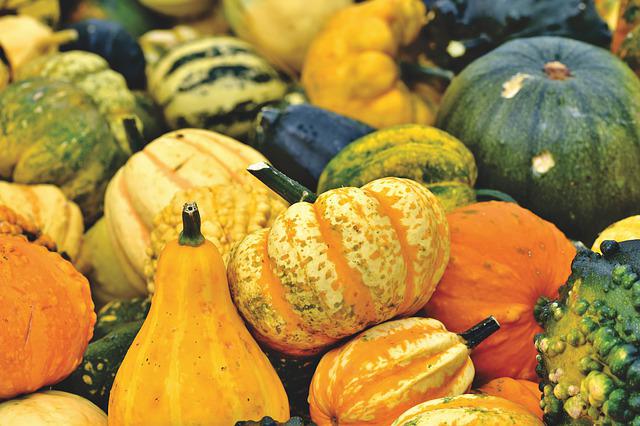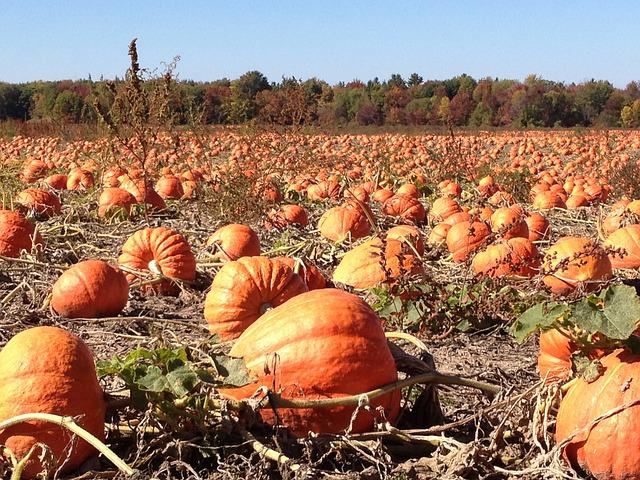How To Grow Pumpkins Vertically? Successfully Growing Pumpkins Vertically

You will need a trellis that is strong enough to support the pumpkins’ weight to grow them vertically. Lattices in the shape of an A work the best for supporting this plant. You’ll have an easier time guiding the vines to form pumpkins if you use their firm and sturdy base support, which has two sides. This helps the plants to remain in place. The adaptability of this shape allows it to complement your garden’s aesthetic in many different ways.
Table of Contents
Can Pumpkins Be Successfully Grown in Vertical Gardens?
Yes! Growing pumpkins vertically requires commitment, diligence, experience, and patience, plus a certain degree of knowledge for the best results. Pumpkin vines have a voracious appetite for climbing, and if you aren’t careful, they will scale anything in their vicinity. Because of this, they are an excellent option for vertical gardens in general.
However, the variety of pumpkins you intend to cultivate should guide your decision regarding the kind of vertical garden to use. Pumpkins of a smaller variety, such as Baby Boo or Hooligan, can be grown successfully on virtually any trellis type. On the other hand, pumpkins of a larger size might require a little bit more assistance. Choose an A-frame or similar trellis style to grow medium or large pumpkins. If you’re going to grow pumpkins that are likely to weigh at least 5 pounds each, you may need to provide them with additional support. To prevent pumpkins from toppling over as they grow, you can construct a sling out of fabric to support them from below.
Once everything is ready, you’re good to go! Depending on weather conditions, harvesting typically lasts from late October until early December. However, there’s no harm in picking sooner if desired! Enjoy your bounty of delicious pumpkins while minimizing environmental impact along the way!
Growing Pumpkins Vertically
1. Find a Location That Has the Ideal Conditions for Developmental Growth
It is important to choose a well-ventilated area when contemplating how to grow pumpkins vertically. This will help your pergola or trellis become more sturdy, but it will also assist your kitchen plant in developing. Pick a location that gets plenty of sunlight and check that the soil has good drainage and is loose and deep.
Various general gardening ideas can be used to grow pumpkins vertically, ranging from wall ideas and garden ideas to pergolas and arches.
- A-frame- Pumpkin is a very stable structure, but it takes up a lot of room and is best for large farms and orchards.
- Arches -are an attractive option, but one must ensure that they are sturdy before beginning to train plants.
- Metal Structures- are ideal for growing pumpkins vertically because they are strong enough to withstand the weight of this garden monster. A decorative metal gazebo that looks great and provides a shady spot to relax in your garden is one option, but you can also use an obelisk as a design element. In addition to supporting your pumpkins, these are a beautiful addition to your garden.
- Pergola- results in a sizeable expansion of the area, and it also has the potential to cast a shadow when combined with other mountains.
- Trellis- Pumpkins have traditionally been grown vertically using a framework that supports their growth. To build livestock pens, cattle trellises are made of metal and feature a grid-like pattern that is highly sturdy. This makes them ideal for supporting the weight of pumpkin plants and their fruit. Affordability and strength make them ideal. It’s possible to build an arch trellis out of cattle panels, which are 16 feet long and 50 inches high. You can also support the pumpkin plants you want to trellis with some structure and then use netting as a trellis to support the plants. For those who do not have the financial means to purchase a more permanent structure, temporary netting can be a viable alternative to consider if it is possible to devise a method for its attachment. These nets are available in several different sizes and can be rapidly erected, dismantled, and relocated to a different locations.
- Tape- is a space-saving way to grow pumpkins vertically. It can be used outside, in greenhouses, and pots.
2. Plant the Seeds of the Pumpkin
When starting from seed, the process is the same no matter what structure you use, so there is no difference. First, you should start by planting seeds in individual pots, then cover them with soil.
About an inch and a half (2.5 cm) deep, plant your pumpkin seeds at the base of your chosen structure. Give the seeds at least 12 inches (30 cm) of space between them.
3. Plant the Seedling in the Final Spot
Plant them in the last spot after they have grown their true leaves. In about a week, you should observe the seeds beginning to sprout. Pumpkin plants produce tendrils, which they wrap around trellises and other vertical supports to climb. Wait until all frostbite has gone away before planting pumpkin seedlings.
4. Tie Pumpkins Together To Make Them Grow Vertically
Tying them to a pergola or trellis as soon as your pumpkins begin to grow at a certain height. Continue to do so as they grow. To control the pumpkin vines, it is also necessary to understand how to cut pumpkin plants.

Making a DIY Trellis
Intimidating as it sounds, building your trellis is quite simple once you have the right tools and a little bit of knowledge.
Begin by gathering all of the supplies you’ll need for the project. A variety of hardware, such as wooden posts or wire, nails or screws, and any other items that you deem necessary, can be included.
To begin, gather your materials and start building your frame. Support beams can be hammered into the ground and fastened with nails or screws, or they can be more elaborately constructed using bent pieces of wood for additional strength.
Regardless of how you build your trellis, make sure it has some structure to keep your plants from falling over.
Finishing touches, like wire grids for vines or carefully arranged twine for creeping foliage, are all that are needed to complete the project. Your very own trellis is ready to be put up!
Height of Trellis
When looking for a pumpkin tray, you should look for one 5 to 7 feet tall and either on the ground or raised. This method can be used for both flat and A-frame trellises.
Before putting pond plants in the ground, you should first get your tray. To protect your A-frame trellis in bed, you can attach a wooden trailer to the fence. Once you’ve done this, you’re ready to plant pumpkin seeds.
Advantages of Vertically Growing Your Pumpkins
- You can quickly identify and control the pests and diseases that attack your plants.
- The plants are kept closer to the ground, which results in better absorption of sunlight and a higher yield of fruits.
- You can save a lot of space by vertically growing your pumpkins.
- Growing pumpkins off the ground give the plants better air circulation.
- When pumpkins are grown vertically, they are also easier to pick because the plants are easier to reach.
What Is The Best Way To Train Pumpkins Onto A Trellis?
Pumpkin trellis training is an integral part of ensuring that your plants are well supported. When your plants are young, pick one of your strongest trellises and gently tie its tendrils to the trellis.
It would help gently wrap your plant’s tendrils around the trellis at as many points as possible to ensure that it grows along the desired route. Your pumpkin plant will quickly start spurring new growth in the direction of the trellis once it has a firm grip on it, and you can gradually train other stems to follow the same path.
Keep doing this every day so the plant can stay on the wire trellis as it grows. Fortunately, this task can be completed in minutes each day. To maximize the amount of space you have for other plants, you should take the time to train your pumpkin plants so that they can grow on trellises.
Should the Vines Be Tied to the Trellis?
The pumpkin vines are typically held to the trellis by their tendrils, which are extremely robust. However, when the pumpkin fruit starts to grow, it might not be bad to give the vines some extra support.
You can gently tie the pumpkin vines to the trellis structure with jute twine or even strips of an old T-shirt. This will help them out a bit more.

How Are the Pumpkins Supported on the Trellis?
When it comes to supporting the pumpkin on the trellis, something must be done because pumpkins can weigh a great deal and exert a great deal of pressure on the vine and stem.
When I first began growing pumpkins vertically in my garden, I used old pantyhose or purchased brand-new ones. If you are using real pantyhose, only the legs are required.
You tie one end of the pantyhose leg to the trellis itself. Place the pumpkin or melon on the hose. Then connect the other end of the hose to the trellis to create a hammock for the pumpkin.
You can also use a mesh or bag to support your pumpkins or melons on a trellis. It depends on what you intend to employ.
Best Vertical-Growing Pumpkin Varieties
Before planting pumpkins in your vertical garden, you should know that not all pumpkin varieties can be grown vertically.
Large pumpkin varieties, such as Mammoth Gold and Jarrahdale, are extremely heavy, and most vertical structures cannot support their weight.
If you have limited garden space at home and would like to grow these pumpkin varieties, you may need to find a community garden with ample space for the vines to spread out.
Jack Be Little, Baby Boo, or this Harvest Mix containing three varieties of small pumpkin seeds, including Hooligan, Gooligan, and Bumpkin, are some of the best pumpkins for growing on a trellis.
